"This goes beyond all known schmoozing.
This is like some kind of virtual-intellectual conspiracy-in-restraint-of-trade."
— Bruce Sterling, "Third Culture Schmoozing"
"The dinner party was a microcosm of a newly dominant sector of American business." — Wired
There's no such thing as a free lunch, or a free Billionaires' Dinner.

Ariane de Bonvoisin - Daniel Gilbert - Eva Wisten?(En route to The Billionaires' Dinner - 2004)
This year, a downsized (or, if you like, more exclusive) Edge dinner was convened in Monterey at the Indian Summer Restaurant.
The dinner, which for the past few years has been held during the annual TED Conference, always has a name attached to it. It began in 1984 as "The Millionaires' Dinner" (thanks to a page one article in The Wall Street Journal) in a Las Vegas Mexican restaurant during COMDEX Eventually it evolved to "The Digerati Dinner"; to "The World Domination, Corporate Cubism, and Alien Mind Control Dinner", to "The Billionaires' Dinner". Last year we tried "The Science Dinner". Everyone yawned. So this year, it's back to the money-sex-power thing with "The Billionaires' Dinner". I realize that "Billionaire" is tired and very '90s, but the name worked for this year's dinner. It was a coincidence that during the dinner, Google cofounder Larry Page received a message on his pager informing him that he and cofounder Sergey Brin had made the ForbesMagazine list of 157 billionaires.
The communications revolution occurring in the age of information and computation has not stopped, nor has it even slowed down. The markets crashed. The innovation continues. And a number of people who showed up for the dinner are really cooking: Jeff Bezos of Amazon; Google's CEO Eric Schmidt, Larry, Sergey, Lori Park, and Megan Smith; Pierre Omidyar, founder of eBay; Dean Kamen, inventor of the Segway; Steve Case, former Chairman of AOL Time-Warner who is now on to new adventures; and Jeffrey Epstein, who recently endowed The Program for Evolutionary Dynamics at Harvard University which is involved in researching applications of mathematics and computer science to biology.
They were mixing it up with the cosmologists Alan Guth (inflationary universe), Leonard Susskind (the landscape of universes), and Paul Steinhardt (the cyclic universe); the physicist Seth Lloyd (quantum computing); the applied mathematician Steve Strogatz (synchronicity in nature); and the psychologists Mike Csikszentmihalyi (flow), Nancy Etcoff (perception of faces), Martin Seligman (positive psychology), Dan Gilbert (mis-wanting), as well as a number of technology and media journalists.
Also attending were Alisa Volkman of the literary-erotic website nerve.com, book packager Ariane de Bonvoisin, and Swedish journalist Eva Wisten. They spent the dinner in rapt conversation with the three cosmologists. "Where were they? I never saw them," said Kevin Kelly. But then Kevin was busy: he and Jeff Bezos, who attended with his mother Jackie, were producing a wall of sound from a table in the middle of the room that made quiet conversation impossible.
An interesting aspect of the dinner was that Seth Lloyd flew in from Tokyo (where he is spending a year) to join us. Seth was the only student of the late Heinz Pagels (who helped to start Edge, and was deeply involved in all its activities). Although I never met Seth when Heinz was alive, I vividly recall Heinz's descriptions of him as the brightest of the bright young physicists...of any generation. Heinz and I had several conversations about how Heinz was attempting to harness Seth's intelligence since he was one of those trans-categorematic individuals. In other words, Heinz was telling me that Seth was unemployable.
Over the years things have worked out for Seth. His seminal work in the fields of quantum computation and quantum communications—including proposing the first technologically feasible design for a quantum computer, demonstrating the viability of quantum analog computation, proving quantum analogs of Shannon's noisy channel theorem, and designing novel methods for quantum error correction and noise reduction—has gained him a reputation as an innovator and leader in the field of quantum computing. He has made the front pages of the world's newspapers several times; collaborates with Murray Gell-Mann; and is now Professor of Quantum-Mechanical Engineering at MIT.
My idea was to use the platform of "The Billionaires' Dinner" and Seth's visit to announce "The Quantum Internet" but I became so caught up in the high energy of of the occasion that I forgot all about it. I also forgot I had a new digital camera in my pocket and didn't take any pictures. Rather than deprive Edge readers of an inside look at the dinner, I sent the following email to the dinner guests:
"Sing for your supper!"
Instead of photos, I plan to run a text portrait. You can help out by responding to the following Edge question (a paragraph or two will
do):"Who were you sitting with? What interesting things were discussed? What did you learn?"
I can recount my own conversation with Lenny Susskind, the father of string theory, who walked in wearing a new sports jacket. I looked at the jacket admiringly, and Lenny told me a story:
"I'm going to Holland next week where I'll have an honorary professorship. Three weeks ago the host called me up and said 'please, get yourself a nice set of clothes, because you're going to meet the queen.' "
" 'Wow,' I said, 'the Queen?'"
"'Yes, the Queen. She wants to meet a physicist,' said my host."
"'That's fantastic,' I replied. 'I'm going to be a guest of honor at a dinner given by the Queen of Holland!' "
"And all of a sudden on the other end of the phone, there's silence. And he says, 'no, Lenny, 'you don't understand; Brian Greene is going to be the guest of honor.' "
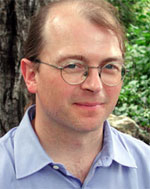
SETH LLOYD
I arrived in Monterey that evening tired and sweaty: my route there from Japan had included climbing a mountain in LA that morning and I hadn't had time to change.
JB immediately tossed me in a corner of the restaurant with Sergey Brin and Larry Page, who grilled me on the potential applications of quantum computation. They were shockingly knowledgeable on the subject and quickly pushed me like a novice sumo wrestler to edge of the ring that marks the boundary between the known and the unknown. That boundary is always closer than one thinks.
We agreed that quantum internet searches are a few years off. I had spent the afternoon in Jeff Kimble's lab at Caltech contemplating the first node of the the quantum internet — a single atom trapped in an optical cavity, capable of exchanging entangled photons with any other nodes, as soon as they are brought into existence. But when the quantum internet has only one node, containing one bit, Q-Google (Quoogle?) is not yet necessary. Sergey and Larry and I noted that when it is up and running, the quantum internet should offer all sorts of wacky possibilities for quantum internet search. Searches could be made significantly more efficient, for example, by using quantum parallelism to explore every node of the quantum internet simultaneously. Problems arise, however, from the fact that quantum bits can't be cloned. I cannot go further into our discussion as that would involve proprietary information concerning quantum internet protocols (e.g., Q-TCPIP).
Sergey broached the subject of massive entanglement and decoherence, a hot topic in quantum information these days (Entanglement is a peculiarly quantum-mechanical effect in which a bunch of quantum systems such as atoms share more information with each other than is possible classically. Entanglement is the branch of quantum weirdness that allows quantum computers to function. Decoherence is a process that destroys entanglement. As I said, these guys were really on top of their quanta).
We discussed recent experiments that Dave Cory and I had done at MIT, and Sergey made a rather fine suggestion for an experiment to test whether gagillions of entangled nuclear spins decohere faster than gagillions of unentangled nuclear spins. Dave and I will check it out.
At this point Jeffrey Epstein joined the conversation and demanded to know whether weird quantum effects had played a significant role in the origins of life. That question pushed me way out of the sumo ring into the deep unknown. We tried to construct a version of the question that could be answered. I was pushing my own personal theory of everything (the universe is a giant quantum computer, and to understand how things like life came into existence, we have to understand how atoms, molecules, and photons process information). Jeffrey was pushing back with his own theory (we need to understand what problem was being solved at the moment life came into being). By pushing from both sides, we managed to assemble a metaphor in which molecules divert the flow of free energy to their own recreational purposes (i.e., literally recreating themselves) somewhat in the way Jeffrey manages to divert the flow of money as it moves from time-zone to time-zone, using that money for his own recreational purposes (i.e., to create more money). I'm not saying it was the right way to describe the origins of life: I'm just saying that it was fun.
SETH LLOYD is Professor of Quantum-Mechanical Engineering, MIT.
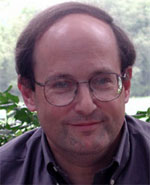
PAUL STEINHARDT
Three of the people I spoke with at the Dinner were Alisa Volkman from Nerve, Steve Petranek of Discover, and Jeff Bezos from Amazon. Alisa and I spoke about the cosmos and film, and creativity in our respective work. Jeff is a Princeton graduate who spent his first three years as a physics major. We talked about physics and engineering at Princeton and the challenge of mentoring young people and helping them excel. Steve Petranek and I talked about dark matter, dark energy and gravity.
PAUL STEINHARDT, father of "The Cyclic Theory of the Universe" is the Albert Einstein Professor in Science and on the faculty of both the Departments of Physics and Astrophysical Sciences at Princeton University.

LINDA STONE
I sat next to Jackie Bezos and Tom Reilly and across from Jeff Bezos and Kevin Kelly. The laughter was so loud, so continuous and so infectious that the conversation gently threaded it's way through the laughter. We talked about Asia, physics and space, outsourcing to India and China, and a whole lot of other thngs that gave us endless pleasure.
It was a magical evening.
LINDA STONE is a former Apple and Microsoft executive.
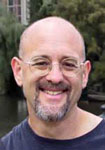
DANIEL GILBERT
I had the pleasure of being seated at the end of a long table and across from Lenny Susskind, so everyone else was pretty much outside my sonic reach. Lenny told me a bit about physics, I told him a bit about psychology, and then we spent the rest of the evening talking about the many odd coincidences in our personal histories. We both had checkered pasts that included more than a little aimlessness, delinquency, truancy, bad grades, and youthful marriages. No one would have bet that we'd ever go to college, much less become professors. Indeed, Lenny and I had so much in common that the only way the waiter could tell us apart was that Lenny invented string theory and I didn't. Good thing I held back on that one, otherwise there would have been some confusion about who got the chicken curry.
DANIEL GILBERT is Professor of Psychology at Harvard University.
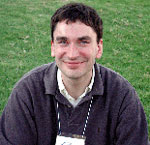
JEAN PAUL SCHMETZ
I sat at a table with Eva Wisten, Paul Steinhardt, Lenny Susskind, Dan Gilbert and Alisa Volkman. It was a wonderful dinner. I talked a lot about media with Eva Wisten (she's a journalist and we publish some 250 magazines). I also discovered that Lenny does not like religion at all (me neither, and I cannot remember how we got to talk about this). Later, I talked to Steven Strogatz and Stephen Petranek but I forgot what we talked about. I remember talking to my old friend Megan Smith for a long time about Space Camp which I plan to go to with my kids soon.
I feel very happy about having been to the dinner and at the same time a bit unhappy not having talked to more people (I guess Dan Gilbert is right about the twisted relationship between choice and happiness).
JEAN PAUL SCHMETZ is Managing Director of CyberLab Interactive Productions GmbH, a subsidiary of the Burda Media Group and a Member of the Executive Board of Burda New Media GmbH.
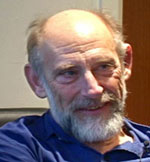
LEONARD SUSSKIND
Larry Page who told me about his experiences taking a physics course from me. The psychologist Daniel Gilbert . We talked a lot about life, love and the pursuit of the ladies. I explained physics and cosmology to him and explained a lot of interesting psych phenomena to me. I loved it. The two young women, Eva and Alisa. We talked about you. I hope they remember more because I don't. But it was for sure the most interesting dinner company that I've had since the old days with my physicist friends Sidney Coleman, Dick Feynman and Jack Goldberg. It could become addictive.
LEONARD SUSSKIND, the father of string theory, is Felix Bloch Professor in theoretical physics at Stanford University.
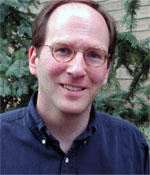
STEVEN STROGATZ
Steve Petranek, the editor of Discover magazine, was sitting on my right. Rodney Brooks, the MIT artificial intelligence researcher who makes little insect-like robots, was on my left. Both are fun and easy to be around. I always like to hear people's life stories, and without too much effort, I managed to get both of them to tell how they got to where they are today. Pertranek told of his days as a cub reporter at various small newspapers, covering all sorts of different areas, from finance to energy (where he did some investigative reporting and once broke a story about some shenanigans at a nuclear power plant, if I remember right). Brooks told charming stories of his days as a kid in Australia, playing out in his shed in the backyard, trying to build computers and other contraptions from spare parts and assorted junk, and nearly electrocuting himself or blowing himself up from time to time. It made me think about the importance of tinkering and fooling around.
It was a real treat—a night to cherish.
STEVEN STROGATZ is an applied mathematician at Cornell University and the author of Sync: The Emerging Science of Spontaneous Order.
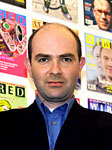
CHRIS W. ANDERSON
After reading of the quantum depths to which Sergey and Larry took Seth, I'm ashamed to recount that I spent most of my dinner asking Alan Guth beginner's questions about quantum communications. He patiently explained the pros and cons of electron vs. photon methods, and the difference between truly encrypted communications and those that simply reveal if they've been tapped by a third party.
Given that this isn't even his field, it was a virtuoso performance of clarity and deduction from first principles. Even better, he then followed up a day or two later with this email:
As I was leaving Monterey I met Robert Gelfond, the CEO of MagicQ Technologies Inc., which is in the business of quantum encryption.
It turned out that almost all of my guesses were right. The currently working systems are not what I would call a true quantum encryption device, which disguises each bit by flipping it or not flipping it according to the spin of an entangled particle. Instead they are quantum intruder-detection devices, which send photons on a light tube. The signal is mixed with a stream of photons with a predetermined pattern of polarizations, which are then verified at the other end. Since an intruder cannot measure the polarization of a single photon, he cannot detect photons and retransmit them in an identical polarization state. I think Robert said that they can send photons up to 50 km with complete security, and up to about 100 km with security that is safe as long as the intruder is limited to present technology. If one wants to go further, one must send the signal in steps of this length, with a secure box at each step which receives the message and retransmits it. There is no quantum algorithm that can detect an intruder who breaks open this box, so it must be secured by ordinary means.
The one point that I didn't foresee is that apparently it is not practical to send all bits by this method. Instead they use the protected photon signal only to distribute frequently changing encryption keys. Then the signal is transmitted separately, using ordinary transmission lines and ordinary encryption, such as perhaps DES. As long as the key is changed frequently, this is regarded as safe.
Most rewarding dinner conversation I've had for ages!
CHRIS W. ANDERSON is Editor-in-Chief of Wired.
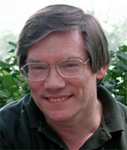
ALAN GUTH, father in the inflationary theory of the Universe, is Victor F. Weisskopf Professor of Physics at MIT; author of The Inflationary Universe.
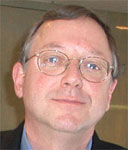
STEVE PETRANEK
I sat next to Steve Strogatz, the Cornell mathematician who wrote one of my favorite books, Sync. He was to my left. To my right was the lyrical, mystical and charming Ariane de Bonvoisin. I sat across from Nancy Etcoff, the research psychologist from Harvard Medical School who has actually defined the word happiness in such depth that it continues to astound me. I kept trying to get some free shrinking from Nancy but she effortlessly shifted the subject of my childhood back to her present research, which was nearly as fascinating.??When others swept Nancy's attention away I turned to Ariane, who unfortunately knows how to work a room full of smart people and kept disappearing. However, I learned enough about her project to publish books that get people through the first 30 days of a crisis (divorce, death of a spouse, realization there isn't a Santa Claus) to know that I'd probably buy each and every one of them even if the crisis didn't match my circumstances (One always has friends in crisis).
Strogatz pulled a reversal by interviewing me before I got to interview him. His descriptions of fireflies along riverbanks syncing up their flashes was far more mesmerizing in person (and after a couple glasses of wine) than it is in the book. Of course, I did my best to stay as far away from Dan Dubno as I could, which turned out to be fairly easy because he was toadying up to Steve Case all night.
As the soiree ended, physicist Paul Stenhardt asked me a few pointed questions about my definition of gravity as I had referred to it in my TED presentation. Besides being embarrassed by my inability to be as clear as a cosmologist can be on what holds us down to this planet, I was fascinated to be led by him to the idea that gravity might be quite different on at least four planes: gravity in very large circumstances, like everything in the universe flying away from everything else at an accelerated pace; gravity on the scale I'm used to as I move across the Earth; gravity in very tiny (quantum) circumstances; and gravity under intense pressure and heat circumstances. All of which made me sorry that dinner came to an end.
STEVE PETRANEK is editor in chief of Discover.
Attendees: Pam Alexander, Alexander Ogilvy; Chris Anderson, TED; Chris Anderson, Wired; Jeff Bezos, amazon.com; Jackie Bezos, amazon.com; Adam Bly, Seed; Stewart Brand, Long Now Foundation; Sergey Brin, Google; Patti Brown, New York Times; Steve Case; Mihalyi Csikszentmihalyi, Claremont; Steffi Czerny, Burda Media; Susan Dawson, Sapling Foundation; Ariane De Bonvoisin; Dan Dubno, CBS News; Jeffrey Epstein, Epstein Assoc.; Nancy Etcoff, Harvard Medical School; Daniel Gilbert, Harvard; Alan Guth, MIT; Katrina Heron; Kevin Kelly, Wired; Seth Lloyd. MIT; Pam Omidyar, Omidyar Foundation; Pierre Omidyar, eBay ; Larry Page, Google; Steve Petranek,Discover; Ryan Phelan, DNA Direct; Tom Rielly, TED; Forrest Sawyer, MSNBC; Eric Schmidt, Google; Martin Seligman, UPenn; Megan Smith, Google; Paul Steinhardt, Princeton; Cyndi Stivers, Time Out New York ; Linda Stone; Steven Strogatz, Cornell; Leonard Susskind, Stanford; Kara Swisher, Wall Street Journal; Yossi Vardi, ICQ; Alisa Volkman, Nerve; Eva Wisten, Bon Magazine; Michael Wolff, Vanity Fair

